Human immunodeficiency virus type 1 genome activation induced by human T-cell leukemia virus type 1 Tax protein is through cooperation of NF-kappaB and Tat
- PMID: 9658145
- PMCID: PMC109905
- DOI: 10.1128/JVI.72.8.6911-6916.1998
Human immunodeficiency virus type 1 genome activation induced by human T-cell leukemia virus type 1 Tax protein is through cooperation of NF-kappaB and Tat
Abstract
For productive replication of human immunodeficiency virus type 1 (HIV-1) in host cells, the viral genome-encoded transactivator Tat and several cellular transcription factors are required for efficient viral gene transcription. However, it remains unclear how the viral genome initiates transcription before Tat is transcribed or when Tat is at suboptimal levels. Here, we utilized the human T-cell leukemia type 1 Tax protein as a molecular tool to investigate the mechanism of viral gene transcription that initiates the early phase of infection of HIV-1. Tax alone does not significantly increase the activity of HIV-1 long terminal repeat (LTR) in T lymphocytes, but it markedly enhanced the replication of an infectious HIV-1 provirus with a truncated nef gene. This enhancement is preferentially mediated by the cooperation of Tax and Tat which is dependent on TAR and duplicated kappaB cis elements of the HIV-1 LTR as well as the NF-kappaB activation domain of Tax. Furthermore, phorbol myristate acetate and membrane-targeted HIV-1 Nef also enhanced the LTR activity in the presence of Tat in the TAR- and kappaB cis element-dependent manner. These data suggest that activated NF-kappaB can functionally interact with a suboptimal amount of Tat and the HIV-1 LTR for efficient initiation of viral gene transcription.
Figures
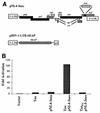
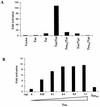


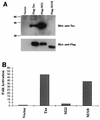
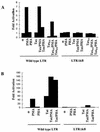
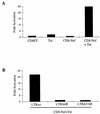
Similar articles
-
Transdominant mutants of I kappa B alpha block Tat-tumor necrosis factor synergistic activation of human immunodeficiency virus type 1 gene expression and virus multiplication.J Virol. 1996 Sep;70(9):5777-85. doi: 10.1128/JVI.70.9.5777-5785.1996. J Virol. 1996. PMID: 8709193 Free PMC article.
-
Human T-cell leukemia virus type 1 Tax shuttles between functionally discrete subcellular targets.J Virol. 2000 Mar;74(5):2351-64. doi: 10.1128/jvi.74.5.2351-2364.2000. J Virol. 2000. PMID: 10666266 Free PMC article.
-
Analysis of the HIV-1 LTR NF-kappaB-proximal Sp site III: evidence for cell type-specific gene regulation and viral replication.Virology. 2000 Sep 1;274(2):262-77. doi: 10.1006/viro.2000.0476. Virology. 2000. PMID: 10964770
-
Regulation of HIV-1 gene expression.FASEB J. 1991 Jul;5(10):2361-8. doi: 10.1096/fasebj.5.10.1712325. FASEB J. 1991. PMID: 1712325 Review.
-
Efficient Non-Epigenetic Activation of HIV Latency through the T-Cell Receptor Signalosome.Viruses. 2020 Aug 8;12(8):868. doi: 10.3390/v12080868. Viruses. 2020. PMID: 32784426 Free PMC article. Review.
Cited by
-
Upregulation of HTLV-1 and HTLV-2 expression by HIV-1 in vitro.J Med Virol. 2008 Mar;80(3):494-500. doi: 10.1002/jmv.21089. J Med Virol. 2008. PMID: 18205225 Free PMC article.
-
Modulation of HIV pathogenesis and T-cell signaling by HIV-1 Nef.Future Virol. 2012 Jun 1;7(6):609-620. doi: 10.2217/FVL.12.42. Future Virol. 2012. PMID: 22844345 Free PMC article.
-
Human T-cell leukemia virus type-I (HTLV-I) tax is not the only one factor to enhance human immunodeficiency virus type-I (HIV-1) infection in culture-supernatants.Virus Genes. 2001;23(1):77-80. doi: 10.1023/a:1011139530768. Virus Genes. 2001. PMID: 11556405
-
Multiple actions of the human immunodeficiency virus type-1 Tat protein on microglial cell functions.Neurochem Res. 2004 May;29(5):965-78. doi: 10.1023/b:nere.0000021241.90133.89. Neurochem Res. 2004. PMID: 15139295 Review.
-
Kaposi's sarcoma associated herpes virus-encoded viral FLICE inhibitory protein activates transcription from HIV-1 Long Terminal Repeat via the classical NF-kappaB pathway and functionally cooperates with Tat.Retrovirology. 2005 Feb 15;2:9. doi: 10.1186/1742-4690-2-9. Retrovirology. 2005. PMID: 15713234 Free PMC article.
References
-
- Ballard D W, Bohnlein E, Lowenthal J W, Wano Y, Franza B R, Greene W C. HTLV-I tax induces cellular proteins that activate the kappa B element in the IL-2 receptor alpha gene. Science. 1988;241:1652–1655. - PubMed
-
- Baur A S, Sawai E T, Dazin P, Fantl W J, Cheng-Mayer C, Peterlin B M. HIV-1 Nef leads to inhibition or activation of T cells depending on its intracellular localization. Immunity. 1994;1:373–384. - PubMed
-
- Berkhout B, Gatignol A, Rabson A B, Jeang K T. TAR-independent activation of the HIV-1 LTR: evidence that tat requires specific regions of the promoter. Cell. 1990;62:757–767. - PubMed
Publication types
MeSH terms
Substances
LinkOut - more resources
Full Text Sources

